Mega Man, known as Rockman in Japan, is a Japanese science fiction video game franchise created by Capcom, starring a series of robot characters each known by the moniker "Mega Man". The original game was released for the Nintendo Entertainment System in 1987, and spawned a franchise that expanded to over 50 games on multiple systems. As of July 2023, the series has sold 40 million units worldwide.
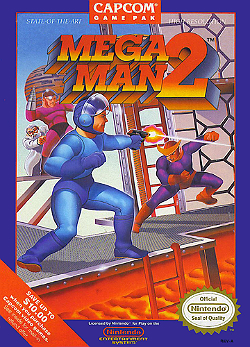
Mega Man 2 is an action game developed and published by Capcom for the Nintendo Entertainment System. It was released in Japan in 1988 and in North America and PAL regions the following years. Mega Man 2 continues Mega Man's battle against the evil Dr. Wily and his rogue robots. It introduced graphical and gameplay changes, many of which became series staples.
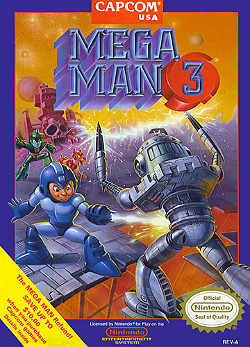
Mega Man 3 is an action-platform video game developed and published by Capcom for the Nintendo Entertainment System. It is the third game of the original Mega Man series and was originally released in Japan on September 28, 1990. The game was released in North America later in 1990 and in European regions by Nintendo in 1992. Taking place after the events of Mega Man 2, the plot follows the titular hero as he helps his creator, Dr. Light, and a supposedly former enemy, Dr. Wily, collect parts for a peace-keeping robot by defeating several Robot Masters that have gone haywire.
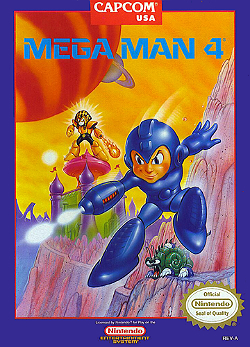
Mega Man 4 is an action-platform game developed by Capcom for the Nintendo Entertainment System. It is the fourth game in the original Mega Man series and was originally released in Japan in 1991. The game was localized in North America the following January, and in Europe in 1993.

Mega Man 5 is an action-platform video game developed by Capcom for the Nintendo Entertainment System. It is the fifth game in the original Mega Man series and was released in Japan on December 4, 1992. It saw a release during the same month in North America and in 1993 in Europe.

Mega Man & Bass is an action-platform video game developed and published by Capcom. It is a spin-off game in the original Mega Man series and was originally released in Japan for the Super Famicom on April 24, 1998. It was later ported to the Game Boy Advance (GBA) handheld in 2002, and localized in English and released the following year.

Mega Man 8 is a platform game developed and released by Capcom in 1996. It was directed by Hayato Kaji and produced by Keiji Inafune, both of whom had previously worked on the series as artists. It is the eighth installment in the original Mega Man series, and was initially released in Japan on the PlayStation in 1996. The following year, Mega Man 8 saw a release on the Sega Saturn and was localized for both consoles in North America and the PlayStation alone in PAL regions. Mega Man 8 is the first game in the series made available on 32-bit consoles. The plot follows series protagonist Mega Man as he is called to investigate an energy reading coming from a recent meteor crash on an island. Mega Man discovers that his nemesis Dr. Wily has run off with the energy source, and sets off to stop Wily's evil plans to use the energy, and to discover the purpose of a mysterious alien robot found at the crash site.
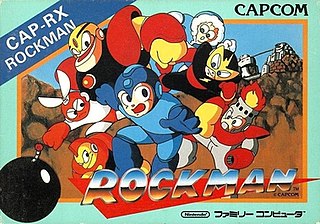
Mega Man, known as Rockman in Japan, is a platform game developed and published by Capcom in 1987 for the Nintendo Entertainment System. It was directed by Akira Kitamura, with Nobuyuki Matsushima as lead programmer, and is the first game of the Mega Man franchise and the original video game series. Mega Man was produced by a small team specifically for the home console market, a first for Capcom, which previously focused on arcade video games.
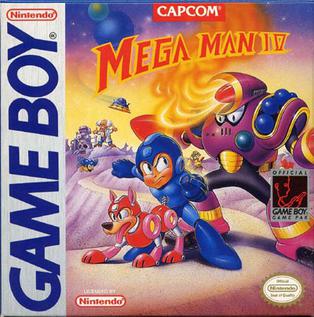
Mega Man IV is an action-platform video game by Capcom for the Nintendo Game Boy. It is the fourth installment in the handheld version of the Mega Man series. The game continues the quest of the protagonist Mega Man in the struggle with his long-time nemesis Dr. Wily, who sends out a disruptive radio signal to cause a rampage, citywide destruction from dormant robots. Mega Man IV features the traditional action platforming gameplay of the prior games while introducing one new feature, the ability to purchase items with power-ups found throughout each stage. As with previous Game Boy releases, the game incorporates gameplay elements and bosses from two sequential Nintendo Entertainment System (NES) games: Mega Man 4 and Mega Man 5. The game has received a warm critical reception. In 2013, Mega Man IV was made available on the Virtual Console of Japan's Nintendo eShop for the Nintendo 3DS. It was later released in the North American and PAL region eShops the following year.
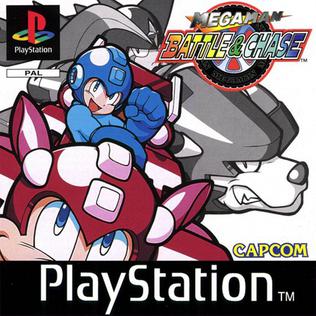
Mega Man: Battle & Chase is a racing video game based on the original Mega Man series from Capcom. The game was released in Japan on March 20, 1997 and in the PAL region on April 3, 1998 for PlayStation. Although it was not released individually in North America, Mega Man: Battle & Chase was featured on the region-exclusive Mega Man X Collection in 2006. Mega Man: Battle & Chase is a traditional racing game with an emphasis on combat. Winning a race allows the player to choose a car part from an enemy competitor as a prize. Reviews for the game have been mixed with many critics drawing comparisons to Nintendo's Mario Kart series.

Mega Man: The Power Battle is an arcade video game and a spin-off title for the Mega Man series. It was released in Japan in 1995 and was followed by a sequel, Mega Man 2: The Power Fighters, the following year. Both games—which were the first and only arcade titles ever to exist within the Mega Man franchise—were ported to home consoles in North America in 2004 as part of the Mega Man Anniversary Collection for PlayStation 2, GameCube, and Xbox and in Japan during the same year as part of two game compilation titled Rockman Power Battle Fighters, also for the PlayStation 2. An adaptation of both games for the Neo Geo Pocket Color, titled Rockman Battle & Fighters, was also made. Both games were later re-released as part of the Capcom Arcade 2nd Stadium compilation in 2022.

Rockman & Forte Mirai kara no Chōsensha is a video game published by Bandai and licensed by Capcom for the WonderSwan handheld system. The game was only released in Japan and is a part of the original Rockman series.

Rockman: Battle & Fighters is a Mega Man fighting game developed and published by Capcom for the Neo Geo Pocket Color handheld system in 2000. It is a portable version of the two arcade fighting games Mega Man: The Power Battle, and Mega Man 2: The Power Fighters. The game involves choosing one of four characters and fighting through a series of boss battles. The game was originally only released in Japan, but was localized in 2022 as Mega Man Battle & Fighters for the Nintendo Switch.

Mega Man 9 is a 2008 action-platform video game developed by Capcom and Inti Creates. It is the ninth numbered game in the original Mega Man series, and the first home console game in the series since Mega Man & Bass (1998). Mega Man 9 was the first game in the series not to have a physical release, and was initially released only on the downloadable gaming services WiiWare, PlayStation Network (PSN), and Xbox Live Arcade (XBLA). In June 2017, it was announced that Mega Man 9 and 10 would have a physical and digital release with their inclusion in Mega Man Legacy Collection 2 for PlayStation 4, Windows, and Xbox One, as well as the Nintendo Switch in May 2018.

Mega Man 6, known in Japan as Rockman 6: The Greatest Battle in History!!, is an action-platform video game developed by Capcom for the Nintendo Entertainment System. It is the sixth installment in the original Mega Man series. It was originally released in Japan by Capcom in 1993, and in North America by Nintendo in 1994. It was included in the Mega Man Anniversary Collection released in 2004. Its first release in Europe and PAL region was June 11, 2013, for the 3DS Virtual Console, nearly twenty years after the game's initial release.

Mega Man, known as Rockman in Japan, is the title character and the protagonist of the Mega Man series by Capcom. He was created by Akira Kitamura for the first Mega Man game released in 1987, with artist Keiji Inafune providing detailed character artwork based on Kitamura's pixel art design.

Mega Man 10 is an action-platform video game developed by Inti Creates and Capcom. It is the tenth main entry of the original Mega Man series. The game was released as a downloadable title for the console gaming services WiiWare, PlayStation Network (PSN), and Xbox Live Arcade (XBLA) during March 2010. The game was also given a physical release along with four other Capcom titles from different franchises in the Capcom Essentials Pack for PlayStation 3 and Xbox 360. It was later released again for a physical and digital release as part of Mega Man Legacy Collection 2 alongside Mega Man 7, Mega Man 8 and Mega Man 9 for the PlayStation 4, Windows, and Xbox One, as well as the Nintendo Switch in May 2018.

Mega Man: Upon a Star, known in Japan as Rockman: Hoshi ni Negai o, is a Japanese anime original video animation (OVA) series based on the popular Capcom video game franchise Mega Man, produced by Universal Multimedia Entertainment, Capcom and Ashi Productions. The OVA was presented by the Japan Center for Intercultural Communications, and acts as a series of educational shorts on the culture of Japan. The episodes were produced circa 1993-1994, and would not be released to home media until a Japanese DVD release by Capcom on September 20, 2002, followed by a release in North America by ADV Films on January 4, 2005, although the order of episodes 1 and 2 from the Japanese release was switched for this release. It loosely adapts the events of Mega Man 5 along with original story elements.

Mega Man 7 is an action platform video game developed and published by Capcom for the Super Nintendo Entertainment System. It is the seventh game in the original Mega Man series. The game was released in Japan on March 24, 1995 and was localized later in the year in North America and Europe.

















